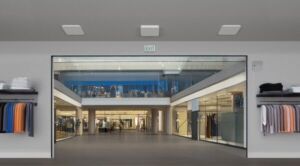In an increasingly competitive and efficiency-driven environment, RFID technology has established itself as a key tool for success in the retail and logistics sectors. RFID tag readers enable accurate inventory control, greater real-time visibility and a significantly improved customer experience.
In this article we explore how RFID readers are being applied in real-world situations to optimise processes, reduce waste and respond to the demands of the modern marketplace.

What is an RFID reader and why is it important in modern retail?
Readers are devices that use radio frequency waves to wirelessly identify and track tags attached to products. In industries such as retail and logistics, RFID tag readers have transformed the way inventory is managed, processes are optimised and losses are reduced.
In retail, RFID readers enable real-time inventory visibility, essential for omni-channel strategies and fast-moving products. In logistics, they improve traceability throughout the supply chain, increasing efficiency and reducing errors.
Fixed vs. handheld RFID readers: which one is best suited to your business?
In order to choose the one that best suits your business, it is important to know what the main features are:
- Fixed RFID readers: Can be installed both in shops and distribution centres. For example, in shops they are used as anti-theft systems or at points of sale.
- Portable RFID readers: Provide flexibility and mobility. Can be used by staff for cyclic counting, replenishment or product tracing. They are ideal for the shop environment or smaller warehouses.
RFID readers at the point of sale: speed, accuracy and a better customer experience
RFID readers at the point of sale have revolutionised the experience for both customers and staff. Thanks to their ability to scan multiple items simultaneously and without the need for direct eye contact, the checkout process becomes much more streamlined and efficient. This allows for considerably faster transactions, as the need to pass each product individually through the reader is eliminated, reducing queues and waiting times.
Finally, the shopping experience becomes smoother and more satisfying for the customer, who enjoys a modern, fast and hassle-free checkout process. In short, RFID readers at the point of sale not only optimise shop operations, but also raise the standard of customer service.
Real-life applications of RFID readers in retail and logistics
Here are case studies where RFID tag readers are making a difference, integrating Checkpoint Systems' expertise and solutions:
Retail
- Real-time inventory management: RFID readers allow hundreds of items to be scanned simultaneously, reducing inventory time and achieving up to 99.99% accuracy. This ensures that products are always available and improves demand planning.
- Loss prevention: RFID solutions integrate unauthorized movement detection, triggering immediate alerts and reducing theft losses.
- Omni-channel fulfilment: Accurate real-time stock visibility facilitates online order picking from physical shops, optimising the omni-channel experience.
- Fitting room and POS analytics: RFID readers installed in fitting rooms and at points of sale (POS) enable the collection of data on customer preferences and behavior, which improves decision-making regarding product range, promotions and shopping experience.
Logistics
- End-to-end traceability: RFID solutions can track products from manufacturing to the end customer, providing transparency and reducing delays in the supply chain.
- Warehouse automation: With coding tunnels and high-speed readers, up to 1,500 items per minute can be processed, speeding order picking and minimising errors.
- Shipment verification and asset tracking: RFID tag readers ensure correct shipping and receiving of products, tracking pallets, containers and returnable tools in real time.
- Sustainable management: Inventory optimisation reduces overstock and waste, contributing to more sustainable and efficient operations.
How to choose the right RFID reader for your shop or warehouse
When choosing an RFID reader, consider the following aspects:
- Use Case: Fixed readers are ideal for high-volume, high-traffic areas, but they can also be used in manual operations, such as an RFID table for shipping processes. Handheld readers, on the other hand, are more suitable for mobile or one-off operational tasks.
- Read volume and frequency: Find readers that fit the dimensions of the project. For example, depending on the use case, high volume projects can be done with fixed readers or more than one handheld.
- Integration needs: Make sure they integrate with your current systems (ERP, POS, WMS).
- Coverage vs. mobility: Evaluate whether you need continuous monitoring or more flexibility.
RFID tag readers are a critical asset for modern retail and logistics operations. From improving inventory accuracy and streamlining checkout processes to enabling end-to-end supply chain visibility, RFID readers are transforming how businesses operate and serve their customers. By understanding the different types of readers and their real-world applications, companies can make informed decisions that drive efficiency, reduce costs, and elevate the customer experience. As retail and logistics continue to evolve, adopting RFID technology is not just a competitive advantage—it's a strategic necessity.
